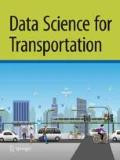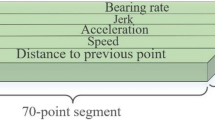Abstract
Inferring transportation mode of users in a network is of paramount importance in planning, designing, and operating intelligent transportation systems. Previous studies in the literature have mainly utilized GPS data. However, albeit the successful performances of models built upon such data, being limited to certain participants and the requirement of their involvement makes large scale implementations difficult. Due to their ubiquitous and pervasive nature, Wi-Fi networks have the potential to collect large scale, low-cost, passive and disaggregate data on multimodal transportation. In this study, by a passive collection of Wi-Fi network data on a congested urban road in downtown Toronto, we attempt to tackle the aforementioned problems. We develop a semi-supervised deep residual network (ResNet) framework to utilize Wi-Fi communications obtained from smartphones. Our semi-supervised framework enables utilization of an ample amount of easily collected low-cost unlabelled data, coupled with a relatively small-sized labelled data. By incorporating a ResNet architecture as the core of the framework, we take advantage of the high-level features not considered in the traditional machine learning frameworks. The proposed framework shows a promising performance on the collected data, with a prediction precision of 81.4% for walking, 80.5% for biking and 84.9% for the driving mode.





Similar content being viewed by others
References
Abadi M, Agarwal A, Barham P, Brevdo E, Chen Z, Citro C, Corrado GS, Davis A, Dean J, Devin M, Ghemawat S, Goodfellow I, Harp A, Irving G, Isard M, Jia Y, Jozefowicz R, Kaiser L, Kudlur M, Levenberg J, Mané D, Monga R, Moore S, Murray D, Olah C, Schuster M, Shlens J, Steiner B, Sutskever I, Talwar K, Tucker P, Vanhoucke V, Vasudevan V, Viégas F, Vinyals O, Warde P, Wattenberg M, Wicke M, Yu Y, Zheng X (2015) TensorFlow: large-scale machine learning on heterogeneous systems. https://www.tensorflow.org/. Software available from tensorflow.org. Accessed Jan 2019
Bantis T, Haworth J (2017) Who you are is how you travel: a framework for transportation mode detection using individual and environmental characteristics. Transp Res Part C Emerg Technol 80:286–309
Beaulieu A, Farooq B (2019) A dynamic mixed logit model with agent effect for pedestrian next location choice using ubiquitous Wi-Fi network data. Int J Transp Sci Technol 8(3):280–289
Blum A, Mitchell T (1998) Combining labeled and unlabeled data with co-training. In: Proceedings of the eleventh annual conference on computational learning theory, pp 92–100
Chen C, Gong H, Lawson C, Bialostozky E (2010) Evaluating the feasibility of a passive travel survey collection in a complex urban environment: lessons learned from the New York city case study. Transp Res Part A Policy Pract 44(10):830–840
Chollet F et al (2015) Keras. https://keras.io. Accessed Jan 2019
Dabiri S, Heaslip K (2018) Inferring transportation modes from GPS trajectories using a convolutional neural network. Transp Res Part C Emerg Technol 86:360–371
Dabiri S, Lu CT, Heaslip K, Reddy CK (2019) Semi-supervised deep learning approach for transportation mode identification using GPS trajectory data. IEEE Trans Knowl Data Eng 32(5):1010–1023
Efthymiou A, Barmpounakis EN, Efthymiou D, Vlahogianni EI (2019) Transportation mode detection from low-power smartphone sensors using tree-based ensembles. J Big Data Anal Transp 1(1):57–69
Endo Y, Toda H, Nishida K, Kawanobe A (2016) Deep feature extraction from trajectories for transportation mode estimation. In: Pacific-Asia conference on knowledge discovery and data mining, Springer, pp 54–66
Farooq B, Beaulieu A, Ragab M, Ba VD (2015) Ubiquitous monitoring of pedestrian dynamics: exploring wireless ad hoc network of multi-sensor technologies. In: SENSORS, 2015 IEEE, pp 1–4
Gong H, Chen C, Bialostozky E, Lawson CT (2012) A GPS/GIS method for travel mode detection in New York city. Comput Environ Urban Syst 36(2):131–139
He K, Zhang X, Ren S, Sun J (2016a) Deep residual learning for image recognition. In: Proceedings of the IEEE conference on computer vision and pattern recognition, pp 770–778
He K, Zhang X, Ren S, Sun J (2016b) Identity mappings in deep residual networks. In: European conference on computer vision, Springer, pp 630–645
Ioffe S, Szegedy C (2015) Batch normalization: accelerating deep network training by reducing internal covariate shift. arXiv preprint arXiv:1502.03167
Kalatian A, Farooq B (2018) Mobility mode detection using WiFi signals. In: 2018 IEEE international smart cities conference (ISC2), pp 1–7
Kingma DP, Ba J (2014) Adam: a method for stochastic optimization. arXiv preprint arXiv:1412.6980
Krumm J, Horvitz E (2004) Locadio: inferring motion and location from Wi-Fi signal strengths. In: Mobiquitous, pp 4–13
Lee DH (2013) Pseudo-label: the simple and efficient semi-supervised learning method for deep neural networks. In: Workshop on challenges in representation learning, ICML, vol 3, p 2
Mäenpää H, Lobov A, Lastra JLM (2017) Travel mode estimation for multi-modal journey planner. Transp Res Part C Emerg Technol 82:273–289
Mun M, Estrin D, Burke J, Hansen M (2008) Parsimonious mobility classification using GSM and WiFi traces. In: Proceedings of the fifth workshop on embedded networked sensors (HotEmNets)
Murakami E, Wagner DP, Neumeister DM (2004) Using global positioning systems and personal digital assistants for personal travel surveys in the United States. In: International conference on transport survey quality and innovation
Nair V, Hinton GE (2010) Rectified linear units improve restricted Boltzmann machines. In: Proceedings of the 27th international conference on machine learning (ICML-10), pp 807–814
Poucin G, Farooq B, Patterson Z (2018) Activity patterns mining in Wi-Fi access point logs. Comput Environ Urban Syst 67:55–67
Reddy S, Burke J, Estrin D, Hansen M, Srivastava M (2008) Determining transportation mode on mobile phones. In: Wearable computers, 2008, ISWC 2008, 12th IEEE international symposium on, pp 25–28
Reed S, Lee H, Anguelov D, Szegedy C, Erhan D, Rabinovich A (2014) Training deep neural networks on noisy labels with bootstrapping. arXiv preprint arXiv:1412.6596
Rolnick D, Veit A, Belongie S, Shavit N (2017) Deep learning is robust to massive label noise. arXiv preprint arXiv:1705.10694
Sohn T, Varshavsky A, LaMarca A, Chen M, Choudhury T, Smith I, Consolvo S, Hightower J, Griswold W, De Lara E (2006) Mobility detection using everyday GSM traces. In: UbiComp 2006: ubiquitous computing, pp 212–224
Srivastava N, Hinton G, Krizhevsky A, Sutskever I, Salakhutdinov R (2014) Dropout: a simple way to prevent neural networks from overfitting. J Mach Learn Res 15(1):1929–1958
Stenneth L, Wolfson O, Yu PS, Xu B (2011) Transportation mode detection using mobile phones and GIS information. In: Proceedings of the 19th ACM SIGSPATIAL international conference on advances in geographic information systems, pp 54–63
Stopher PR, Greaves SP (2007) Household travel surveys: where are we going? Transp Res Part A Policy Pract 41(5):367–381
Toronto TCo (2014) Travel times - bluetooth. https://www.toronto.ca/city-government/data-research-maps/open-data/. Accessed June 2018
Wang H, Calabrese F, Di Lorenzo G, Ratti C (2010) Transportation mode inference from anonymized and aggregated mobile phone call detail records. In: Intelligent transportation systems (ITSC), 2010 13th international IEEE conference on, pp 318–323
Wang H, Liu G, Duan J, Zhang L (2017) Detecting transportation modes using deep neural network. IEICE Trans Inf Syst 100(5):1132–1135
Xiao Z, Wang Y, Fu K, Wu F (2017) Identifying different transportation modes from trajectory data using tree-based ensemble classifiers. ISPRS Int J Geoinf 6(2):57
Yazdizadeh A, Patterson Z, Farooq B (2019a) An automated approach from gps traces to complete trip information. Int J Transp Sci Technol 8(1):82–100
Yazdizadeh A, Patterson Z, Farooq B (2019b) Ensemble convolutional neural networks for mode inference in smartphone travel survey. IEEE Trans Intell Transp Syst 21(6):2232–2239
Yazdizadeh A, Patterson Z, Farooq B (2019c) Semi-supervised gans to infer travel modes in GPS trajectories. arXiv preprint arXiv:1902.10768
Zheng Y, Li Q, Chen Y, Xie X, Ma WY (2008) Understanding mobility based on GPS data. In: Proceedings of the 10th international conference on Ubiquitous computing, pp 312–321
Zhu X (2005) Semi-supervised learning literature survey. Tech. Rep. 1530, Computer Sciences, University of Wisconsin-Madison
Author information
Authors and Affiliations
Corresponding author
Ethics declarations
Conflict of Interest
The authors declare that they have no conflict of interest.
Additional information
Publisher's Note
Springer Nature remains neutral with regard to jurisdictional claims in published maps and institutional affiliations.
Rights and permissions
About this article
Cite this article
Kalatian, A., Farooq, B. A Semi-Supervised Deep Residual Network for Mode Detection in Wi-Fi Signals. J. Big Data Anal. Transp. 2, 167–180 (2020). https://doi.org/10.1007/s42421-020-00022-z
Received:
Revised:
Accepted:
Published:
Issue Date:
DOI: https://doi.org/10.1007/s42421-020-00022-z




